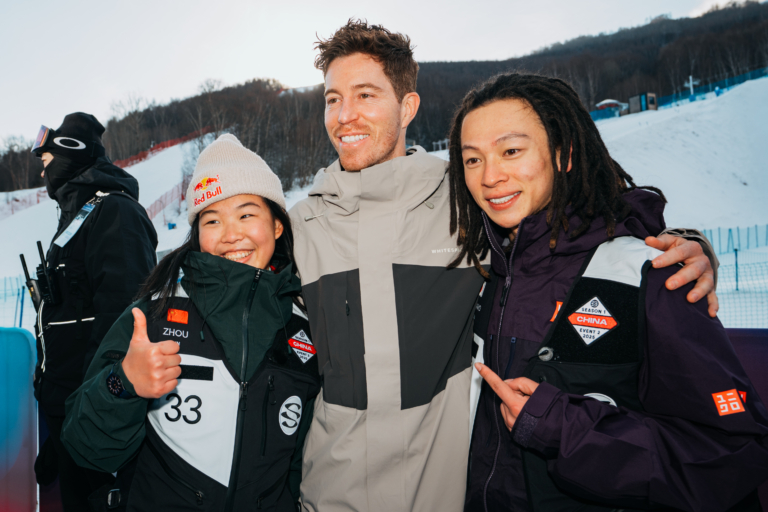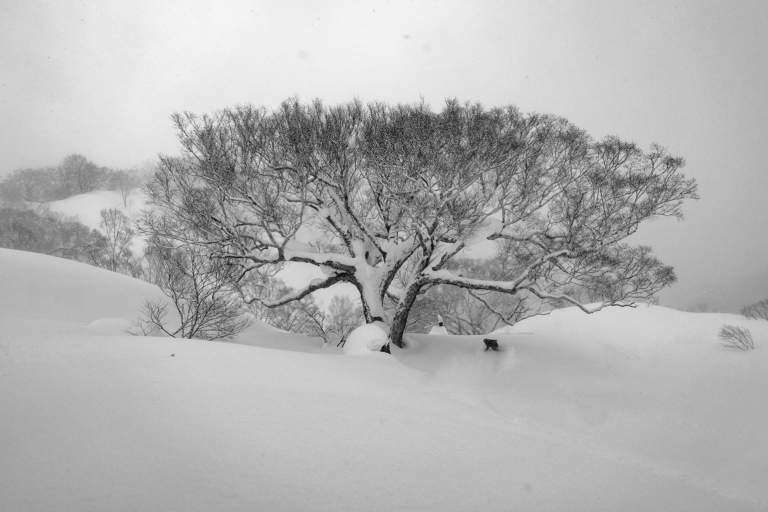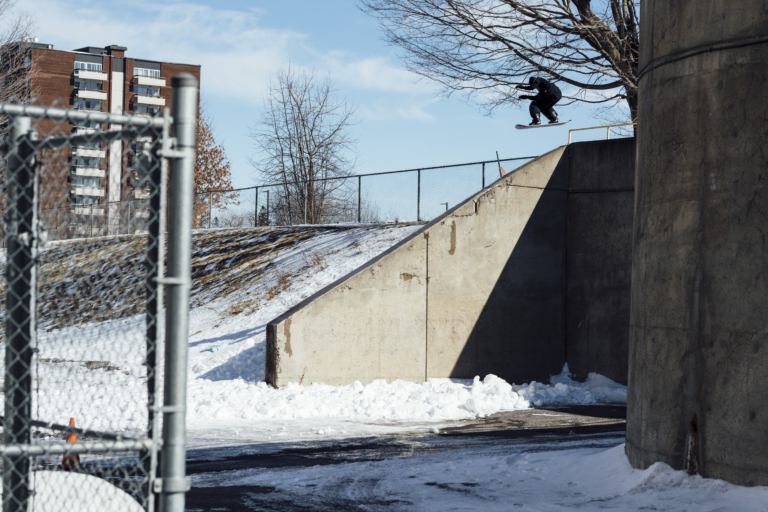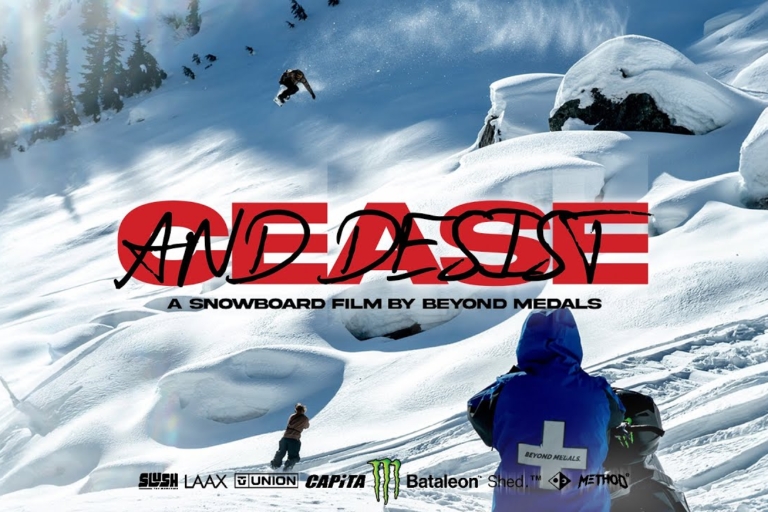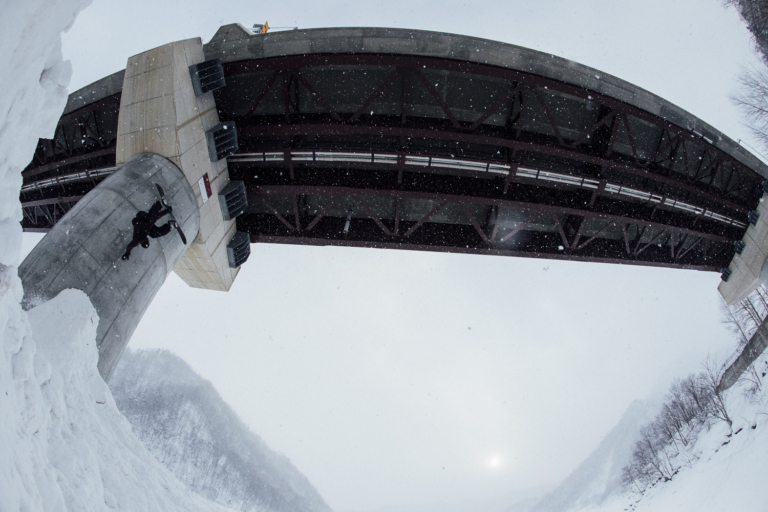Since its inception two years ago, the Natural Selection Tour has appeared multiple times on SportsCenter’s Top 10. It’s been talked about by the New York Times, CNN, Forbes, and Wired (this is in addition to all of the core snowboarding coverage, too). NST is, essentially, everywhere, and in every iteration of coverage of the Tour, a wholly authentic side of snowboarding is shown to a larger, mainstream audience–much of whom have likely never seen anything like it before–and this allows snowboarding to tell its own story in a big way. This doesn’t happen magically, though; genuine coverage like this is the result of the behind-the-scenes work of Lora Bodmer, who has been sharing the stories of snowboarding and through that, helping to shape the way people see and experience the sport and its culture, since the early 2000s. Even if you haven’t met Lora, you’ve definitely seen things she’s done. Her resume reads like a chronology of rad, snowboarding benchmarks: She worked on That’s It, That’s All, The Art of FLIGHT, Dear Rider, Supernatural and Ultra Natural, and for Mervin and Jones, TGR, ASR, Red Bull, and Asymbol (and this is a VERY abridged list). Lora’s role is in communications, as a publicist (for lack of a better word) for films, projects, brands, and causes she believes in. But that description belies the influence and impact that her roll entails. Lora says it best below, but she is a master of finding stories in snowboarding that beg to be told and connecting these ideas with people to tell them from different perspectives and for different outlets. And all of this is rooted in her dedication to riding. Growing up on the East Coast and spending her formative years in Jackson Hole, Lora is a diehard ripper and this love of snowboarding and the community it fosters shines through all of the work that she does. Now, living just north of San Diego with her son, Lora is the owner of Deep Communications, from which she works on many of the biggest projects in snowboarding every calendar year. She is also the senior director of media and PR for Protect Our Winters, a role that further allows her combine dedication to what she believes in with the work that she does on a systemic, change-making scale. While so much of Lora’s work may be behind the scenes, the impact that she has in snowboarding (and more) is front and center. – Mary T. Walsh

Name: Lora Bodmer
Stance: Reg
Job title: Owner/Publicist Deep Communications, Sr. Director of Media and PR for POW
Where you’re from: The East Coast (But really, Wilson, WY)
Where you live: Cardiff-by-the-Sea, CA
Home Mountain: Mammoth, CA and Jackson Hole, WY
Instagram: @LoraBodmer
What is your current job and can you tell us a little bit about what your role entails?
I’m a publicist, for lack of a better word. As the owner of Deep Communications, I work with Natural Selection Tour, Red Bull Films and other major film projects on media, messaging, and PR. I’m also the Sr. Director of Media and PR for Protect Our Winters.
Basically, I help people tell inspiring or important stories in ways that can make a difference. Sometimes the storytelling helps to ensure that a film or event reaches audiences in powerful ways, or that someone with a beautiful story has a way to share that with others. Or other times that a cause gains support or advocacy effort gains steam to drive a desired change. But at the core, I’m empowering people with great stories to share and connect them with the best avenues to share their story in really authentic, meaningful ways.
What does a typical day at work look like for you?
Days are very different depending on if I’m at home, or at a Natural Selection Tour stop, or in DC with Protect Our Winters. But at home, there’s a lot of emailing, too many Zoom meetings, a few hours of writing, dog walks, and gardening while on work calls, a bike ride for school drop-off, and if I’m lucky, a 45-minute dip in the Pacific Ocean to get my head right.
How did you start snowboarding?
I started skiing as a kid and by the time I was twelve, all I wanted to do was to crew up with the older kids wearing baggy clothing, kicking back on the mountain to hit tiny kickers built into the side of Tussey Mountain and Blue Knob near where I lived. They were part of something that felt bigger than making turns and I wanted in. So I got a hand-me-down K2 and a pair of Airwalk boots that were easily two sizes too big, but the smallest they had, and sent it. Mostly sent my heels right out of the binding that first season…but once I grew into the boots, it was on.
When did you know that you wanted to work in the snowboard industry?
After working in politics and campaigns straight out of college, I started flooding Burton with my resume. They were probably wondering what on earth they’d do with a political hack from DC and never responded. After September 11 happened, when I watched the Pentagon burn from my office window in DC, I thought…there must be more to all of this. Life is short. Fuk it. I’m going snowboarding. So, I hopped in with my boyfriend at the time who was heading out to be a snowboard instructor in Jackson Hole for the winter. I’d lined up a press secretary job for a Senate campaign in Colorado the following spring, but when spring came around, I couldn’t pry myself out of Jackson. There’s that saying, “come for a summer, stay for a winter and you’ll never leave.” We left, but it was reluctantly, after an epically raucous decade.
What was your first job in the industry?
In Jackson, I discovered the budding (and ridiculously fun) world of outdoor PR. After banging down Carson Stanwood’s door for a season, he finally gave me a job. The first week of work we hosted a bunch of media at Jackson Hole, where we rode backcountry with guides, went night sledding, hot tubbed, tested new gear and I was like, “Ohhhhh, work can be really, really fun.” My clients at Stanwood included the ASR show, which used to be where the action sports industry met up and all the snowboard films premiered in San Diego every September.

Between that first job and now, how did you get to where you are currently?
I hustled and stayed nimble. From Stanwood, I started freelance writing for a dozen media outlets and then started Deep Communications where I worked with Red Bull, Quiksilver, helped Jeremy launch Jones Snowboards, Mervin Mfg, Reef, ASR, Surf Expo, at least ten films, the Red Bull Super Natural and Ultra Natural, and so many other really fun projects.
Before having my son, I went in-house at the international music association, NAMM, and played executive for a few years. Pantyhose and a big office with a view. Luckily it was in the music industry, so I still found purpose and passion in it, even if there were fewer powder days. That experience was like getting a masters in corporate PR, but more importantly, it allowed me to reconnect with political and advocacy work through NAMM’s efforts to ensure that all kids have access to music education. That lead to a job running communications for an Obama White House program called Turnaround Arts, which worked to prove a theory that an infusion of arts and music can help to turn around some of the country’s most challenged schools.
Now, I pull from the last twenty-three (how did that happen???) years of experience on politics campaigns and advocacy work to help athletes to share their stories in a way that can move action on climate forward with Protect Our Winters. And I’m so fortunate to still be on the wild Travis Rice ride for the revolutionary Natural Selection Tour. And to have the opportunity to continue to support Red Bull’s award-winning documentary projects including most recently The Alpinist and Dear Rider, both projects that personally moved me in profound ways.

What experiences or lessons have been most valuable to you to get to where you are?
Don’t give up. You may not hear back from ten pitches, or some weeks 100, but if you have a good story to tell and are positioning it in a powerful way to the right people, it will find a home.
Stay nimble. I’ve now worked through three big national economic downturns, starting out of college with the tech bubble bursting in the late 90s into September 11th uncertainty, when my candidates lost in, clients went bankrupt, contracts dried up, tradeshows folded. By staying nimble and keeping a few pots on the stove, you can navigate the inevitable downturns. But I don’t ever allow my business or work style to grow too big, too slow or too comfortable—even when times are flush.
What do you feel are some of the most important skills or areas of knowledge necessary for your current role?
Technically you need to be able to write and communicate clearly. It is also valuable to personally understand and be really passionate about what you are working on. That authentic passion and deep firsthand knowledge of the topic shines through in your pitch and work with journalists.
What is a skill that you didn’t necessarily think would apply to your current role, but has proven to be invaluable?
Snowboarding. 🙂

What is a challenge in your current role that you didn’t expect and that you have had to navigate?
Even ten years ago, it would have been hard to predict how much media would have changed and how many fewer media outlets there would be—how stretched the journalism field would be. WhenThat’s It, That’s All came out in 2008, I had a towering stack of print magazine covers and clips on my desk to show for it. More than half of those outlets are gone now or fully digital.
With my job being to help people, films, events share their stories—usually as far and wide as possible—having maybe 25-50% fewer outlets to do that has completely changed how I work. But, I’m especially happy that Snowboard Magazine is back!!!
While it is a challenge in some ways, with that has come the new opportunities of storytelling through social media and video—we just have to keep evolving. But my heart hurts every time a title folds.
How do you deal with set-back professionally?
I get outside for a surf or to make some turns, take a few breaths of fresh air and then lace up to get back in it. For every set-back, there are a few steps forward just ahead.
Who and/or what do you look up to in the industry for inspiration?
I admire a lot of the athletes who I’m friends with and have had the pleasure to also work with. Jeremy Jones, who had the vision to start Protect Our Winters well before climate was top of mind in snowboarding and has had the drive to grow it into a massive force in the climate movement worldwide. Mountain biker Rebecca Rusch, who defines persistence, tenacity, and grit on and off the bike. Travis Rice, who sees possibilities in a whole different dimension and inspires evolutions in every aspect of snowboarding that he touches, from films to events to riding itself. And Kimmy Fasani, who is not only a revolutionary in snowboarding, but also one of the truly kindest, most real people in snowboarding, with a brilliant touch for bringing humanity back to our sport.

What do you feel has been your biggest impact in your area of work?
My goal has been to bring snowboarding to the masses, but in core, authentic ways, and through meaningful storytelling. That started when we introduced the world through mainstream media to core snowboarding with massive media efforts around That’s It, That’s All and The Art of FLIGHT. This was real, core snowboarding that we all love, but featured in the Vanity Fair, Wall Street Journal, USA Today, Playboy, ESPN, Sports Illustrated, GQ, Men’s Health, global news outlets. Our hope was that we were inspiring people with our sport in a way that was authentic and beyond gimmicks, growing our community, but also inspiring with new ways to see the natural world.
Combining that type of authentic story telling with purpose-driven work, as I do with Protect Our Winters, takes the meaningfulness of landing a media placement to a whole new level. The audience for that piece of media coverage is going to hopefully be inspired and informed, but also empowered to do something that can help to save snowboarding, our community, and the Earth for future generations.
What keeps you driven and motivated in your line of work?
I love landing the big, beautiful placements for my clients. The meaningful, unique ones in core snowboarding outlets with deeper storytelling, but also those big ones that no one expects, where we reach new audiences who probably never even think of snowboarding. And BAM, there are our friends and heroes on screens or covers worldwide. We landed five minute, global CNN pieces on Natural Selection Tour and another on Protect Our Winters this winter that reached 450 million people worldwide. Seeing the response and impact to those types of placements fires me up to reach for bigger opportunities for my clients.
Working in snowboarding is a wonderful, yet often complex combination of our personal passion and professional life. How has this come into play in your experience working in the industry?
I feel very fortunate in that my work is also a part of who I am, part of my identity. There have been moments where I have felt like for personal/family reasons that I should dial it back…but the people, experiences and life that working in snowboarding open for me play a much bigger part in my life than just a job or a paycheck. So at those times, I’ve tended to dive even farther in to my work and the snowboarding community around it.

If someone was interested in doing what you do, what would you recommend they pursue to reach this goal—whether areas of education or certification, ways to get experience, skills to hone, things to learn, individuals to follow, books to read, internships to apply for, jobs to take, whatever it may be—what do you recommend?
Learn to write—well. PR, marketing, and snowboarding, in general, need more people who love to ride, but can also communicate clearly and professionally. So, take some journalism courses or major in it rather than in PR or Marketing. In my line of work, it is most helpful to understand what makes a good story, the elements to tell it in a powerful way and then you can become a real asset to your clients and the journalists you are pitching.
And when it comes to internships and first jobs, say, “YES!” Take risks, try new things, stretch yourself, work your ass off, and have fun.
Lastly, best piece of advice someone has ever given you that applies to your professional life that could be helpful for someone reading this?
I had a boss who told me it is a marathon, not a sprint. I sprint from project to project, deadline to deadline. It’s exhausting. But, I’m trying to pace myself and prioritize better, so that I can do this another twenty years.

